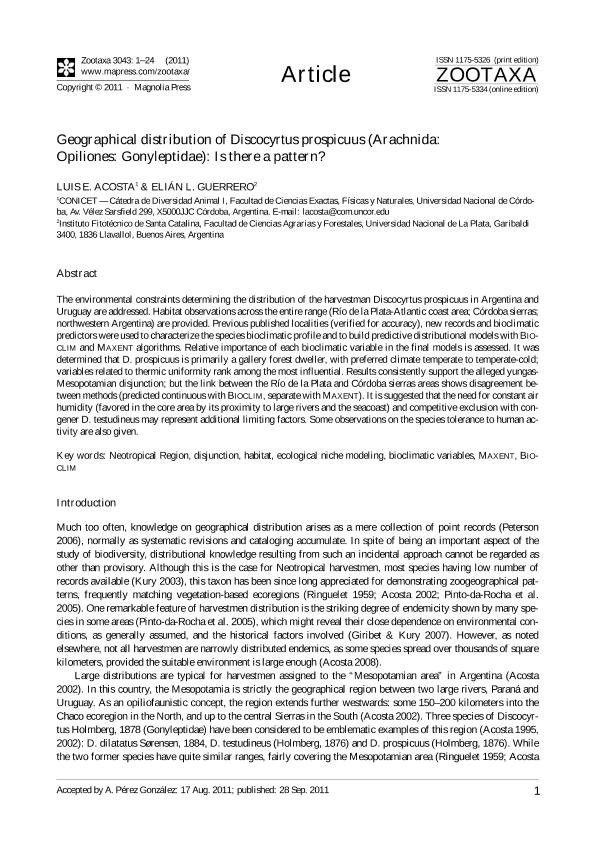Mostrar el registro sencillo del ítem
dc.contributor.author
Acosta, Luis Eduardo

dc.contributor.author
Guerrero, Elián Leandro

dc.date.available
2024-03-08T15:01:40Z
dc.date.issued
2011-09
dc.identifier.citation
Acosta, Luis Eduardo; Guerrero, Elián Leandro; Geographical distribution of Discocyrtus prospicuus (Arachnida: Opiliones: Gonyleptidae): Is there a pattern?; Magnolia Press; Zootaxa; 3043; 1; 9-2011; 1-24
dc.identifier.issn
1175-5326
dc.identifier.uri
http://hdl.handle.net/11336/229868
dc.description.abstract
The environmental constraints determining the distribution of the harvestman Discocyrtus prospicuus in Argentina andUruguay are addressed. Habitat observations across the entire range (Río de la Plata-Atlantic coast area; Córdoba sierras;northwestern Argentina) are provided. Previous published localities (verified for accuracy), new records and bioclimaticpredictors were used to characterize the species bioclimatic profile and to build predictive distributional models with BIOCLIMand MAXENT algorithms. Relative importance of each bioclimatic variable in the final models is assessed. It wasdetermined that D. prospicuus is primarily a gallery forest dweller, with preferred climate temperate to temperate-cold;variables related to thermic uniformity rank among the most influential. Results consistently support the alleged yungas-Mesopotamian disjunction; but the link between the Río de la Plata and Córdoba sierras areas shows disagreement betweenmethods (predicted continuous with BIOCLIM, separate with MAXENT). It is suggested that the need for constant airhumidity (favored in the core area by its proximity to large rivers and the seacoast) and competitive exclusion with congenerD. testudineus may represent additional limiting factors. Some observations on the species tolerance to human activityare also given.
dc.description.abstract
The environmental constraints determining the distribution of the harvestman Discocyrtus prospicuus in Argentina and Uruguay are addressed. Habitat observations across the entire range (Río de la Plata-Atlantic coast area; Córdoba sierras; northwestern Argentina) are provided. Previous published localities (verified for accuracy), new records and bioclimatic predictors were used to characterize the species bioclimatic profile and to build predictive distributional models with BIOCLIM and MAXENT algorithms. Relative importance of each bioclimatic variable in the final models is assessed. It was determined that D. prospicuus is primarily a gallery forest dweller, with preferred climate temperate to temperate-cold; variables related to thermic uniformity rank among the most influential. Results consistently support the alleged yungasMesopotamian disjunction; but the link between the Río de la Plata and Córdoba sierras areas shows disagreement between methods (predicted continuous with BIOCLIM, separate with MAXENT). It is suggested that the need for constant air humidity (favored in the core area by its proximity to large rivers and the seacoast) and competitive exclusion with congener D. testudineus may represent additional limiting factors. Some observations on the species tolerance to human activity are also given.
dc.format
application/pdf
dc.language.iso
eng
dc.publisher
Magnolia Press

dc.rights
info:eu-repo/semantics/openAccess
dc.rights.uri
https://creativecommons.org/licenses/by-nc-sa/2.5/ar/
dc.subject
Neotropical Region
dc.subject
disjunction
dc.subject
habitat
dc.subject
ecological niche modeling
dc.subject.classification
Ecología

dc.subject.classification
Ciencias Biológicas

dc.subject.classification
CIENCIAS NATURALES Y EXACTAS

dc.title
Geographical distribution of Discocyrtus prospicuus (Arachnida: Opiliones: Gonyleptidae): Is there a pattern?
dc.type
info:eu-repo/semantics/article
dc.type
info:ar-repo/semantics/artículo
dc.type
info:eu-repo/semantics/publishedVersion
dc.date.updated
2024-03-05T13:20:26Z
dc.identifier.eissn
1175-5334
dc.journal.volume
3043
dc.journal.number
1
dc.journal.pagination
1-24
dc.journal.pais
Nueva Zelanda

dc.journal.ciudad
Auckland
dc.description.fil
Fil: Acosta, Luis Eduardo. Universidad Nacional de Córdoba. Facultad de Ciencias Exactas, Físicas y Naturales. Cátedra de Diversidad Animal I; Argentina. Consejo Nacional de Investigaciones Científicas y Técnicas. Centro Científico Tecnológico Conicet - Córdoba. Instituto de Diversidad y Ecología Animal. Universidad Nacional de Córdoba. Facultad de Ciencias Exactas Físicas y Naturales. Instituto de Diversidad y Ecología Animal; Argentina
dc.description.fil
Fil: Guerrero, Elián Leandro. Universidad Nacional de La Plata. Facultad de Ciencias Agrarias y Forestales. Instituto Fitotécnico de "Santa Catalina"; Argentina. Consejo Nacional de Investigaciones Científicas y Técnicas; Argentina
dc.journal.title
Zootaxa

dc.relation.alternativeid
info:eu-repo/semantics/altIdentifier/url/https://www.biotaxa.org/Zootaxa/article/view/zootaxa.3043.1.1
dc.relation.alternativeid
info:eu-repo/semantics/altIdentifier/doi/https://doi.org/10.11646/zootaxa.3043.1.1
Archivos asociados
